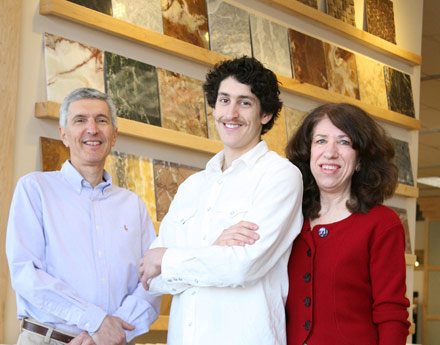Tall ceilings, natural light, and efficient LEDs create a spacious showcase for Green Building Supply’s products and materials. (Photos by Juliet Jarmosco, jarphoto.com)
In the new green Building Supply showroom, a light-filled emporium in Fairfield for eco-friendly home building products, owner Joel Hirshberg shows a young couple around the kitchen display area, happily sharing his voluminous knowledge of green products and construction materials. It’s no surprise that customer service comes so easily to Joel, as he’s a fourth-generation retailer. In fact, Joel spends so much time talking to customers—on the phone and in person, taking as long as needed to answer all their questions—that his wife, Joy, compares him to a therapist or marriage counselor.
Helping customers navigate the myriad of green products available today is a Hirshberg family tradition. Joel, Joy, and their son, Aaron, who joined the firm five years ago, personally test the products and materials they sell, and they’re constantly vetting new innovations.
The Family That Goes Green Together . . .
Founded by Joy in 1991, Green Building Supply has expanded considerably from its modest one-room beginnings. Now located in a 1930s brick building near the the square in Fairfield, the spacious showroom stocks a dazzling array of paints, flooring, kitchen cabinets, cleaning supplies, and more.

Joel, Aaron, and Joy Hirschberg
Renovating the sturdy old structure gave the Hirshbergs a chance to put their dual passions for green building and customer education to work. “We wanted to inspire people to take something that they had, something old, and make it look beautiful and new,” Aaron says. Although all the finishes are new in order to showcase the products they sell, the Hirshbergs preserved and reused large chunks of drywall and two-by-fours and kept the original radiators.
Joel recently discovered that his grandfather and great-grandfather both owned dry good stores in Michigan in the early 1900s. Coincidentally, the new building is strikingly similar in appearance to Joel’s great-grandfather’s original store: both are two-story brick buildings with corner locations.

Displays in the Green Building Supply Showroom.
A Green Space for Eco-Education
With plenty of space available for educational workshops, the new showroom is as much a learning center as it is a retail store. Joel points out the many ways that customers can interact with products, from trying out stains and paints on different surfaces and in different lights to slipping off their shoes and directly experiencing radiant floor heating. Joy jokes that the showroom is a bit like the interactive displays in an educational museum, except that everything in their museum is for sale.
The Many Shades of Green
As consumers become increasingly aware of harmful toxins in conventional construction materials, more are looking for earth-friendly solutions. But what does building “green” really mean? Aaron points out that “the word ‘green’ means so much to so many different people it almost needs to be redefined.” Some people care only about energy efficiency, while others care only about non-toxic products—with a whole a range of people in between who just want to do the right thing for themselves and the environment. “Everyone has a different take,” he says. “and it’s our job to see what it means to that customer and then point them in the right direction.”
So what is the most important area to focus on when tackling a green construction project? Based on Joel’s experience helping customers who have gotten sick after exposure to toxic building materials, he puts non-toxic products first, followed by energy efficiency and carbon footprint. But, he cautions, “Everybody has to make their own decisions about what’s important to them based on where they are in their lives and what their budget is.”
Joel compares trying to use 100 percent green building materials to trying to eat 100 percent organic food. “People do as much as they can,” he says. “It’s really hard to go 100 percent of anything, even building green. People who have all the money in the world—even they have a really hard time.”
The Other Green: Price vs. Cost
What if you don’t have all the money in the world to build or remodel green? Isn’t building green expensive? Joel tells me that the answer is not a simple one, but depends on whether you take the short-term or the long-term perspective.
Aaron explains, “Most people don’t understand the difference between price and cost. Price is what you pay today off the shelf, and that’s what most people think of as cost,” rather than thinking about what using that product will cost over time.
According to Joel, while building green can have a 5 to 10 percent higher initial price, the payoffs in durability, health protection, and energy savings mean that it can cost less in the long run. And Joel points out that not every green product is higher in price than conventional building materials. So even if your budget is tight, it’s worth researching green options.
What’s Next?
Aaron believes that just as public awareness of the dangers of smoking led to a decrease in the number of smokers, increased awareness of the importance of saving energy, taking care of the planet, and preserving health is driving an increase in greener building.

A view toward the front door conveys the loftiness of the light-filled showroom.
The truth of this is reflected in both Green Building Supply’s own success and the exponential growth of the industry as a whole. Joel estimates that the green building industry is worth $53 billion today, and figures from the U.S. Green Building Council seem to indicate that the industry could be worth hundreds of billions in just a few years.
With 23 years’ experience of winnowing out the latest innovations in ecowise materials, Green Building Supply stands poised to keep new generations living with the very best earth-friendly materials possible.
